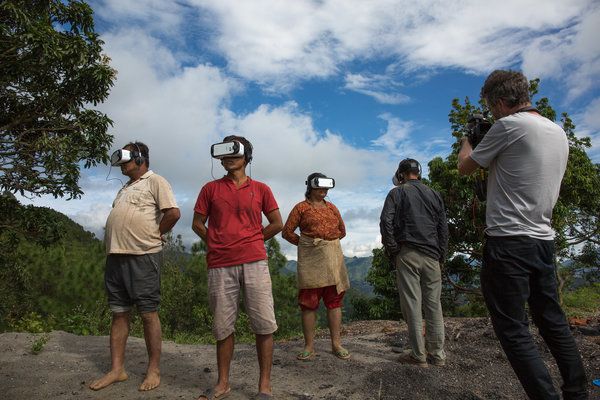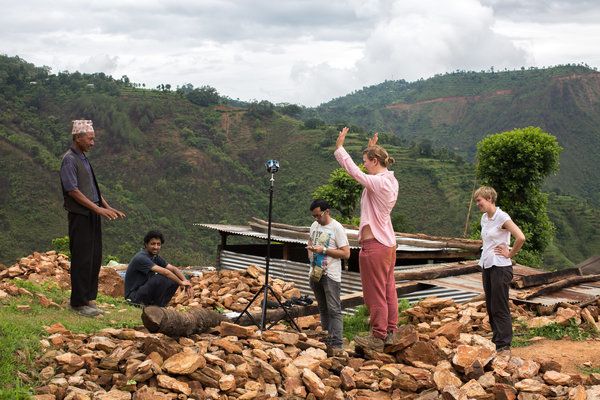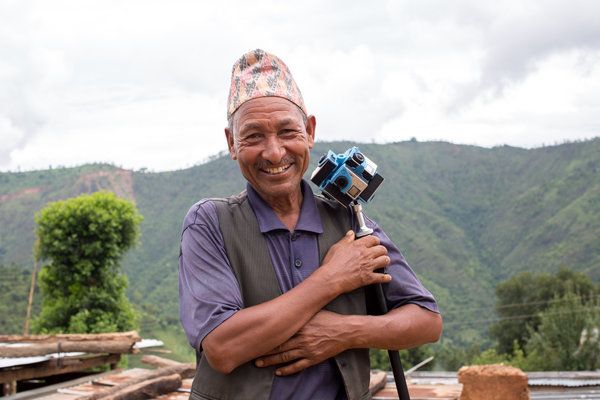If you’d happened to be on an isolated Nepalese hillside last week, you’d have been greeted by the somewhat unexpected sight of a group of native villagers – most of whom share one tap of running water between households – sitting on the ground, losing themselves in the latest in VR technology.
With their modern headsets, this group from the community of Kharelthok was watching themselves caught on camera by the film team at WaterAid, a tireless group determined to bring their latest offering to a whole new audience.
Film manager Steve Melia explains why it was time for something new when it came to their technological approach.
“I think that we know that a lot of people in the UK aren’t going out of their way to find films by charities, and the story that we’ve told in Kharelthok of Krishna and the others is one we’ve told lots of times, people overcoming challenges to make their lives better.

“By using VR we hoped to attract people as interested in the technology as they are in the story, people who wouldn’t necessarily be hanging out for the next WaterAid film might want to find more about us and what we do.
Watching a VR film definitely has its own charm, something you can try out for yourself with the WaterAid offer of your own Google cardboard headset – see below.
Steve ponders the novelty: “The technology is still so new that people are fascinated by things they wouldn’t be fascinated by on flat film. You show a picture of a goat right next to you and you’re looking on a VR set, you start thinking, ‘Wow, I wonder what happens next.’”
For the film’s director and producer Catherine Feltham, the advantage of the VR experience is how absorbing the final product becomes, in a market where viewers’ attention spans is a prized commodity.

“When I watched my first VR film, I was blown away,” she remembers, citing the UN’s VR film on Syria - ‘Clouds over Sidra’ - as her inspiration.
“I thought I’d been in there three minutes, and it turned out to be ten minutes. I couldn’t believe it, how they’d got my attention.
“Hopefully, we can get this out to early adopters of this technology, not our usual audience, people used to reviewing gaming apps, so that’s very exciting.”
‘Aftershock’, the team’s film documenting the devastation caused by the 2015 earthquakes in this region of Kavre and the villagers’ inspiring response to their profound challenges, was filmed using a 360Heros Pro7 GoPro Rig. The footage has then been ‘stitched’ together using the Autopano software to create a 360 degree picture. Adobe Premiere and After Effects were used for the edit. The sound mix was done in Ableton Max for Live 9.6.
You can download ‘Aftershock’ through the following app links:
Google play store: http://bit.ly/AftershockVRplay
Apple i-store: http://bit.ly/AftershockVRapp
Although the VR cameras themselves are small and easily portable, filming with so many brought its own challenges out on a baking hot, remote Nepalese hillside.
Catherine remembers the physical challenge of clambering up and down the hills of the village to get her shots amid the inhospitable climate and landscape.
“Charging up cameras every night took hours, the heat meant battery life was halved when you’re miles away from the nearest power source, all the cards needed changing and the cameras overheated just when we were filming, which could be really frustrating, so we had to manage those challenges. It’s pretty fiddly.”

For Steve, the filming process itself took a new approach.
“You have to direct when you can’t be in the scene, you get the cameras rolling, you expect the scene to unfold, but then you have to go and hide behind a tree.
“We had one little boy who loved the camera, he was always trying to jump in front of it, and if you’re hiding behind the house trying to direct the scene, it’s hard to know if he’s even there until you look back at the film and there he is surprising you. You didn’t even know you didn’t capture what you meant to, but it’s a sweet out-take…” See the little photo-bomber in action below...
Although the film is available to watch flat on their website, WaterAid’s plan is to distribute the VR film, and the means to watch it in all its 360 glory by sending our free headsets using Google cardboard.
Catherine explains:
“It’s accessible and can be flat-packed. You’re giving something to people for free, they can use it to watch our film, and then use it to watch other films. We have an offer promotion on them at the moment for people in the UK, which might go to other countries later on once we’ve tested.
“In the first five days, there have been 500 orders, so there’s obviously an appetite for it. So hopefully people are enjoying it.”
‘Aftershock: Nepal’s untold water story’ was produced and directed by WaterAid’s in-house film team. It’s based in a community where WaterAid is working with support from the HSBC Water Programme, which has reached more than a million people with safe water and two million with sanitation to date.
They will be distributing VR headsets using Google cardboard - click here for further info.
